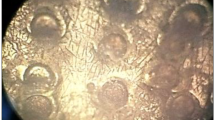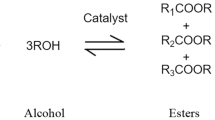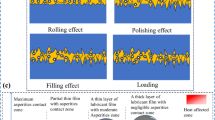Abstract
Expanded worries about the ecological harm brought about by mineral oil-based lubricants have made a developing worldwide trend of advancing vegetable oil as base oil. Along these lines, this paper presents the tribological performance of palm oil blended with hexagonal boron nitride (hBN) nanoparticles as an environment-friendly lubricant. The hBN nanoparticles were 70 nm and were blended with the palm oil at varying concentrations that ranged between 0 and 0.5 vol.%. The samples were blended by using the sonication technique, with the help of an ultrasonic homogenizer. Thereafter, the tribological test was conducted using a four-ball tribometer as indicated by engineering standard testing method (ASTM D4172-94). The surface morphology and chemical composition of the worn surfaces were observed using the scanning electron microscopy (SEM) installed with energy-dispersive X-beam spectroscopy (EDX). Results showed that when hBN nanoparticles were blended with palm oil, the unsteady-state coefficient of friction (COF) was promptly changed to a steady-state condition during the running-in period. However, the higher concentration of hBN nanoparticles causes higher COF. Furthermore, 0.1 vol.% of the hBN nanoparticles in palm oil exhibited lower COF and wear rate compared with the palm oil alone and commercially available engine oil SAE 15W40.









Similar content being viewed by others
References
8 things to know about palm oil. WWF Report 2018. https://www.wwf.org.uk/updates/8-things-know-about-palm-oil (accessed online on 21 Dec 2020)
Abdullah MIHC, Abdollah MFB, Amiruddin H, Nuri NRM, Tamaldin N, Hassan M, Rafeq SA (2014a) Effect of hBN/Al2O3 nanoparticles on engine oil properties. Energ Educ Sci Technol A Energy Sci Res 32(5):3261–3268
Abdullah MIHC, Abdollah MFB, Amiruddin H, Tamaldin N, Nuri NM (2014b) Effect of hBN/Al2O3 nanoparticle additives on the tribological performance of engine oil. J Teknol 66(3):1–6
Abdullah MIHC, Abdollah MFB, Amiruddin H, Tamaldin N, Nuri NRM (2016) The potential of hBN nanoparticles as friction modifier and antiwear additive in engine oil. Mech Ind 17(1):104
Amiruddin H, Abdollah MFB, Idris AM, Abdullah MIHC, Tamaldin N (2015) Stability of nano-oil by pH control in stationary conditions. Proc Mech Eng Res Day 2015:55–56
Barber GC, Lee JC, Ludema KC (1987) Materials and surface finish effects in the breaking-in process of engines. J Eng Gas Turbines Power 109(4):380–387
Çelik ON, Ay N, Göncü Y (2013) Effect of nano hexagonal boron nitride lubricant additives on the friction and wear properties of AISI 4140 steel. Part Sci Technol 31(5):501–506
Lim CY (2014) Addressing palm oil concerns. The Star Online. https://www.thestar.com.my/news/environment/2014/09/08/addressing-palm-oil-concerns (accessed online on 21 Dec 2020)
Lovell M, Higgs CF, Deshmukh P, Mobley A (2006) Increasing formability in sheet metal stamping operations using environmentally friendly lubricants. J Mater Process Technol 177(1–3):87–90
Nawi AAEBM, Abdullah MIHC, Abdollah MFB (2018) Dispersion stability of hBN nanoparticle in liquid phase with different dispersion agents. J Mech Eng 15(2):143–153
Rao TVVLN, Rani AMA, Awang M, Baharom M, Uemura Y, Iskandar PDR (2018) An overview of research on biolubricants in Malaysia and Japan for tribological applications. J Tribol 18:40–57
Reeves CJ, Menezes PL, Lovell MR, Jen TC (2013) The size effect of boron nitride particles on the tribological performance of biolubricants for energy conservation and sustainability. Tribol Lett 51(3):437–452
Ren S, Meng J, Wang J, Lu J, Yang S (2012) Tribo-corrosion behaviors of Ti3SiC2/Si3N4 tribo-pair in hydrochloric acid and sodium hydroxide solutions. Wear 274:8–14
Shashidhara YM, Jayaram SR (2010) Vegetable oils as a potential cutting fluid—an evolution. Tribol Int 43(5–6):1073–1081
Wang Y, Wan Z, Lu L, Zhang Z, Tang Y (2018) Friction and wear mechanisms of castor oil with addition of hexagonal boron nitride nanoparticles. Tribol Int 124:10–22
Acknowledgements
The authors gratefully acknowledge contributions from the members of the Green Tribology and Engine Performance (G-Tribo-E) research group, Universiti Teknikal Malaysia Melaka.
Author information
Authors and Affiliations
Corresponding author
Additional information
Publisher’s note
Springer Nature remains neutral with regard to jurisdictional claims in published maps and institutional affiliations.
Rights and permissions
About this article
Cite this article
Abdollah, M.F.B., Amiruddin, H. & Jamallulil, A.D. Experimental analysis of tribological performance of palm oil blended with hexagonal boron nitride nanoparticles as an environment-friendly lubricant. Int J Adv Manuf Technol 106, 4183–4191 (2020). https://doi.org/10.1007/s00170-019-04906-5
Received:
Accepted:
Published:
Issue Date:
DOI: https://doi.org/10.1007/s00170-019-04906-5




